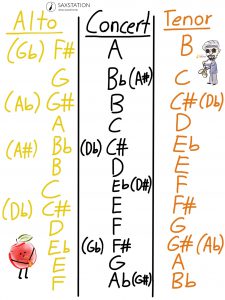Search Results for: transposing
Transposing for Saxophones, Video
A fairly expansive video about transposing, you can go to the downloads page to get a chart. And/or check out the related posts. Leave a comment if you still have questions.
“We are debating about transposing an alto sax into a standard “c” tuned guitar that is playing in the key of “F” …
Question that I received about transposition for alto sax.
Hi Neal
Please can you help me out, I am having a very heated debate with a soon to be ex friend lol… We are debating about transposing an alto sax into a standard “c” tuned guitar that is playing in the key of “F” …
I say the notes i need to play are: C# E F# G AB C C #
He says that I need to play : D E F# G A B C# D
Please can you let me know who of us is the idiot
Many thanks and kind regards
Matthew
If the guitar is playing in F, that means D on the alto sax.
Just like an Eb on the guitar would be a C on the alto sax. Eb to C is down a minor third. F to D is down a minor third.
It sounds like your friend is right.
You wrote, C# E F# G AB C C # though. I see two sharps and both C and C#…. I don’t understand what you mean by that. How did you get to those notes?
-Neal
Basically I was saying that after having given it some thought I was probably wrong and felt like an idiot, now that you have confirmed it, I really feel like and idiot lol
Basically the way I had worked it out was I wrote down the c scale, bad worked out what I would have to play on the sax to get that, and with that sax “c” scale, I started at F and made everything there on 3 half steps down, where as I should have taken the f scale and done that, but yes I feel silly now haha
Thank you for your help
Regards
Matthew
You just got mixed up about how transposition works, but since you had this debate with your friend, I think you will probably remember it well from now on!
-Neal
Saxophone Transposition Chart
I have been asked quite a few times about how the notes work on saxophones, what you see on a tuner, etc.
So here’s a chart. Concert notes in the middle alto (and bari on the left) and tenor (and soprano) on the right. You can also compare alto to tenor on the same row.
If you’re having trouble with transposing, you could save this image on your phone for reference.

Go to https://saxstation.com/downloads to get a larger version, a fingering chart, and some other things. Follow the directions and subscribe to get access if you have not already.
“What are the twelve major scales on saxophone?”
 Starting on each note
Starting on each note
You can start a major scale on any of the 12 different notes in an octave. Theoretically you can call some of these notes different names, but that doesn’t change what they sound like.
You name a scale based off of the first note.
Here are the twelve notes
C, C#, D, Eb, E, F, F#, G, Ab, A, Bb, B
I used a combination of flats and sharps in the names according to the way I usually think of them.
You can think of scales in terms of solfege, solfa, solfeggio, and the other names for the syllables.
The first note will be do
Do, Re, Mi, Fa, So, La, Ti, Do
For the major scale. That can be a useful system, I used in it in a few classes with singing. But generally I think of the letters in music. You change the syllables a little to raise or lower them by a half step.
Transposing
If you play saxophone, you probably should know about transposing.
Circle of Fifths
A way to practice the twelve major scales would be around the “circle of fifths”
C F Bb Eb Ab C# F# B E A D G
Moving in that direction is similar to the movement of the V chord to the I chord which happens often in music as a resolution.
Four Major Scales
Here are four of the major scales
Saxophone Scales – How to Play C Major Scale on Sax – SaxStation
Saxophone Scales – C# Major Scale – SaxStation
B Major Scale on Saxophone – SaxStation
Saxophone Scales – Ab Major Scale – SaxStation
Same Interval Pattern, Similar Sound
What I would actually recommend is learning the scales initially by reading them, but then trying to really remember and recognize the sound of the major scale. If you do that, you should be able to play a major scale starting on any note.
Basically, the scales become much more useful if you have memorized them.
Order of Flats and Sharps
You will see patterns in the scales as well, especially if you play them in certain orders.
In this order,
C F Bb Eb Ab C# F# B E A D G
You add a flat each time as you progress to the right. After Ab, you go to C# which has 7 sharps and then you begin subtracting one sharp as you go the right.
The flats in a key signature go in a certain order:
Bb, Eb, Ab, Db, Gb, Cb, Fb
The sharps go in the opposite order
F#, C#, G#, D#, A#, E#, B#
If you would like to learn more, check out my Class About Scales
“I’ve been playing the alto sax for approximately 25 years… for some unknown reason, I’m unable to get my chords to flow like a true sax player.”
Mr. Neal, I’ve been playing the alto sax for approximately 25 years… for some unknown reason, I’m unable to get my chords to flow like a true sax player.
My family and friends thinks that I’m good, but in my personal opinion, I stinks.
I can read music, but my ear training needs a lot of work….and yes, my ultimate goal is for my sax to control the mood of the audience….
what do you recommend…..
-Danny
My Response:
You can sign up for my program Saxophone Tribe if you want to work with me on those things.
Thanks
-Neal
Dave Chapelle Knows Two Songs on Piano – One is Round Midnight
Comedian Dave Chapelle knows only two songs on the piano- one of them is Round Midnight by Thelonious Monk (the other is Misty). He tells us this and plays Round Midnight in his movie ‘Block Party‘ that came out a few years back.
Chapelle talks about Thelonious Monk’s timing being so ‘ill’. Which is pretty true.
The other day I was working on learning ‘Round Midnight’ – it’s a tune I had played a while back, but had somewhat forgotten.
The chord changes are not easy to play over! Even Miles Davis has trouble when he was playing the song at first.
One thing I tried, actually by accident, was reading off of a part in C. So I mostly learned the melody in that key and then realized that it was in fact in C and I was playing a tenor sax.
After that, I looked back at a Bb version, but saw it was slightly different. The C version seemed closer to the unembellished melody.
So I started learning it in the original key by looking at the version in C and transposing as I went along. For tenor sax and soprano this isn’t too bad, since you just go up a whole step. A bit trickier for alto and bari.
As I played Round Midnight like that, I saw that I was mostly looking at the shape and not the notes themselves, so it seemed like it could help me in memorizing tunes as a sort of intermediate step.
Ideally, you want to know songs in all keys, so this process forced me to pay attention to the intervals.
Any thoughts on this?




